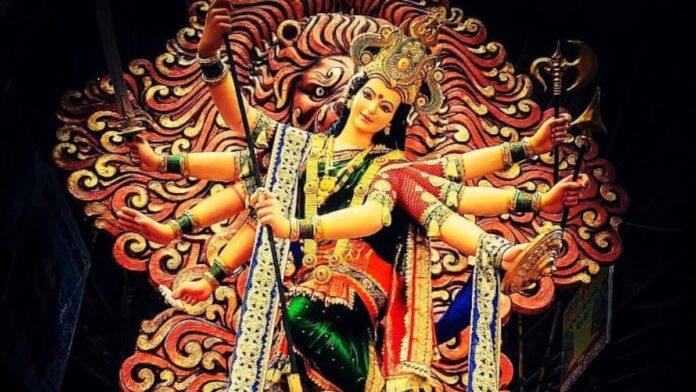Ma Durga is the protective form of Shakti, burning up all ignorance, as her fiery nature energises our highest motivation. The Devi-Mahatmya (Greatness of the Goddess) glorifies the Mother Goddess as the embodiment of the Earth, in which she sustains, nurtures and cares for all living beings. In her transcendent state, she is the blissful Queen of the Universe who rules over all existence with majesty and grace.
By Yogini Shambhavi Devi
“Durga” in Sanskrit means difficulty, a fort, a place that is hard to conquer, yet also indicates the means of overcoming all difficulties and gaining all difficult attainments. Durga is Durgatinashini, “the one who eliminates all difficulties and suffering.” She steers the ship of our minds through the troubled waters of samsara, the illusory world of maya, helping us cross the ocean of ignorance. Durga as the sublime Mother Goddess shields her devotees from the turmoil of life and alleviates the most severe sorrow.
Ma Durga is the protective form of Shakti, burning up all ignorance, as her fiery nature energises our highest motivation. Her radiant wisdom dispels the darkness within us, removing inertia, turbulence and attachment. She represents the golden-red flame in the spiritual heart, where we learn to concentrate deeply in order to experience enduring meditative bliss.
Like Shiva, Ma Durga has three eyes. Her left eye (moon) represents Divine love; Her right eye (sun) represents transformative action; and Her central eye (fire) discriminating knowledge, the three aspects of the universal light.
She lifts the veils of maya that underlie our material nature – kama (desire), krodha (anger), mada (intoxication), moha (delusion), lobha (greed), ahamkara (arrogance of the ego) and matsara (jealousy). Her light steers us through the struggles we face at a soul level, helping us work through and move beyond our karmas.
Durga’s symbolism
Ma Durga’s vehicle is the regal lion, representing executive power, will and determination. Her riding the lion symbolises Shakti’s mastery over all the forces of life, reminding the devotee that one must possess unwavering strength to maneuver through the dualistic realm of the ego.
Durga carries in her numerous hands the magical weapons bestowed on her by the Devas. Each has a particular power and capacity.
1. The conch shell represents “pranava”, the supreme mantra “Aum”, the universal sound vibration: Bow and arrow represent focused energy. By holding both bow and arrows in one hand Durga indicates her control over both aspects of energy as potential and kinetic.
2. The thunderbolt signifies firmness and insight. The devotee of Durga must be firm like a rock in conviction. Like the thunderbolt that cuts through everything with its lightning force, without being affected itself, the devotee needs to move through every challenge without losing confidence and resolve.
3. The half-open lotus symbolises certainty of success but not yet finality. The lotus in Sanskrit is called “pankaja” which means born of the mud. It stands for the continuous evolution of our inner consciousness amidst all negativity, want and confusion.
4. The sudarshan chakra or discus, which spins around the index finger of the Goddess while not touching it, signifies that the entire world revolves around her dynamic presence. She uses this unfailing weapon to destroy intractable evil and produce a peaceful environment conducive to the growth of dharma.
5. Her sword reveals discriminating knowledge (viveka), which has the sharpness of a razor-like blade. Knowledge free from all prejudice, doubts and distortions is reflected in the shimmer of its light.
6. Durga’s trident or trishula indicates the three primary qualities of Nature as sattva (balance), rajas (energy) and tamas (inertia) – and Shakti as the remover of all the three types of pain, physical, mental and spiritual.
7. Durga makes the gesture of fearlessness, “abhaya mudra”, granting deliverance from all possible dangers. The Universal Mother is calling her devotees: “Surrender all actions and duties unto me and I will release you from all fear, including death itself.”
Navratra: Nine nights of worshipping the Goddess
Navratra celebrates the Supreme Goddess in her myriad cosmic manifestations of Shakti: Ma Durga (protection), Sri Lakshmi (abundance), Sri Saraswati (knowledge) and Mahakali (transformation).
On the first three days, Ma Durga is propitiated for dispelling negativity and misfortune. On the next three days, Lakshmi Devi is revered as the beautiful goddess of wealth and prosperity for both spiritual and worldly endeavours.
During the last three days, Saraswati Devi is worshipped for bestowing deep learning and profound wisdom. Ma Kali is invoked for the highest transcendence. We also worship the nine forms of Ma Durga throughout the Navratra, one for each day: Shailaputri, Brahmacharini, Chandraghantha, Kushmanda, Skanda Mata, Katyayani, Kalaratri, Mahagauri, Siddhidatri.
On the ninth day of Navratra celebrations, Mahanavami, Kanya Puja is performed, where nine young girls are worshipped as living forms of the Goddess.
Their feet are washed to welcome the goddess and show our respect for Her. Food, delicacies and gifts are offered to the girls. There is also the auspicious custom of planting barley seeds (hariyali) in a small earthen pot filled with sand on the first day of Navratra. The ensuing barley grass is nurtured with deep faith and offered to the goddess on the ninth day as cultivation of mindful devotion.
On the tenth day, Vijaya Dashami, as Mahishasura-Mardini, Durga destroys Mahishasura, the demon who indicates the powers of ego, duality and conflict, proclaiming the eternal victory of truth over falsehood, dharma over adharma, and immortality over death!
In honouring the Great Mother Goddess we must always remember Mother Earth, Mother Nature and the Cosmic heavens, recognising her as the Mother of all. Then we will reclaim our own nature as one with Her boundless radiance that is all-pervasive!
Jai Ma Guru!
This article first appeared in www.vedanet.com and it belongs to them.








